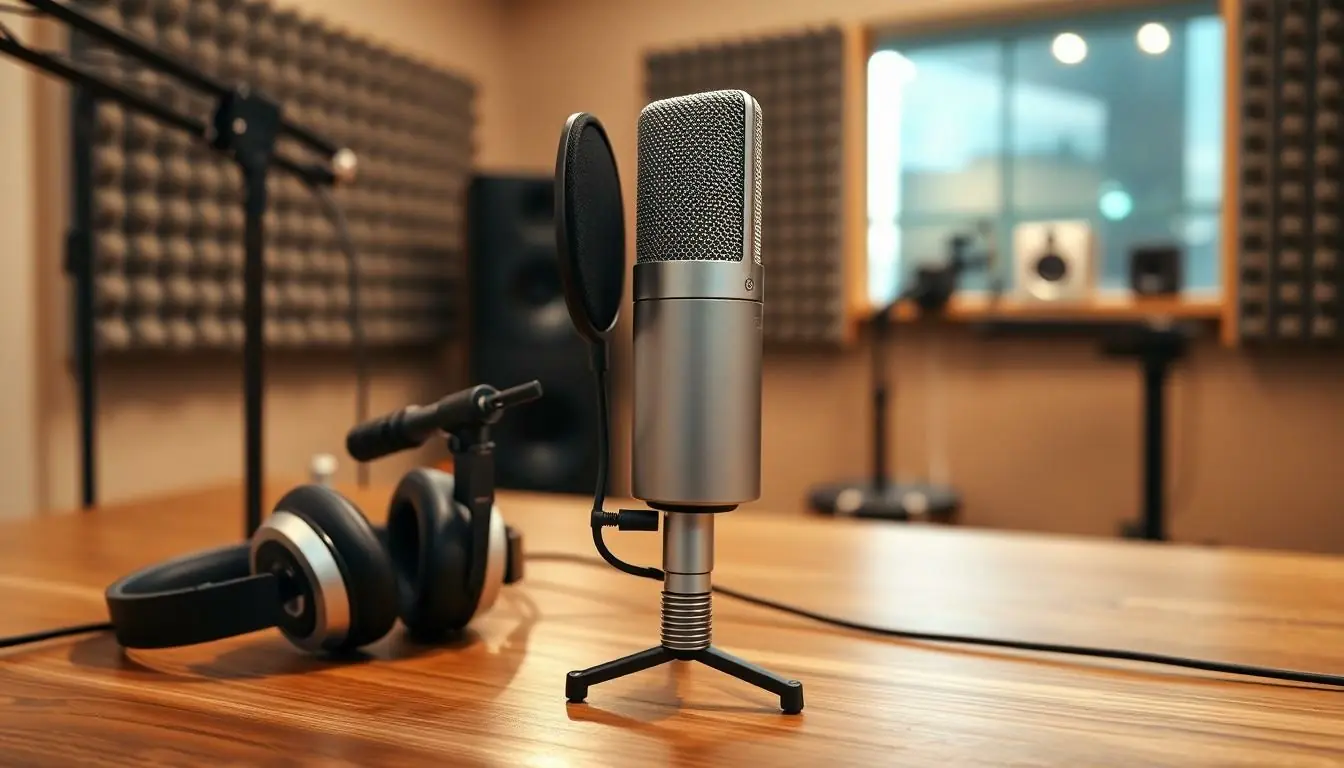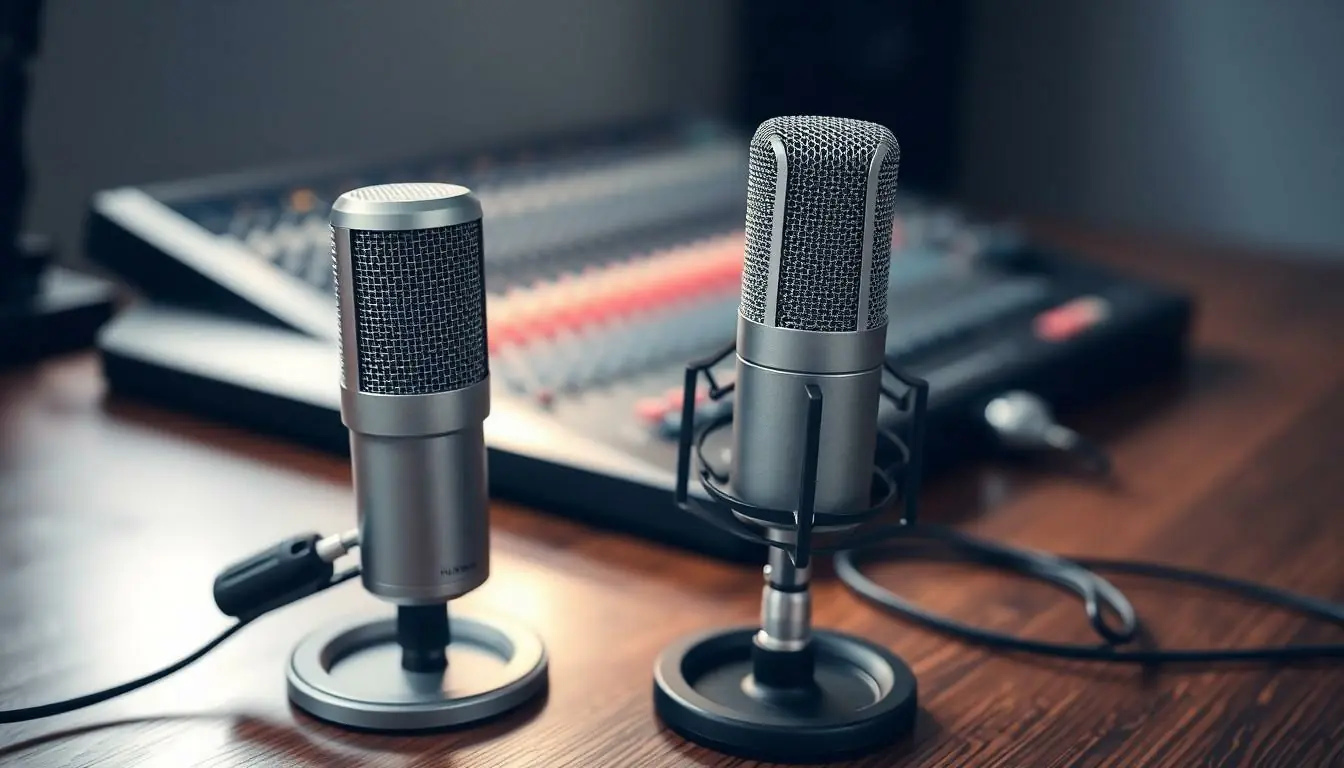Table of Contents
ToggleIn the world of podcasting, your voice is your brand, and the right microphone can make all the difference. Imagine speaking into a mic that captures your words with crystal clarity while filtering out the background noise of your neighbor’s cat choir. That’s the magic of a quality podcasting mic. It’s not just a piece of equipment; it’s your trusty sidekick on the journey to audio greatness.
Whether you’re a seasoned pro or just starting, choosing the right mic can feel like finding a needle in a haystack—or worse, picking the wrong one and sounding like you’re broadcasting from a potato. With so many options out there, it’s crucial to know what to look for. Let’s dive into the world of podcasting mics and discover how to elevate your audio game without sacrificing your sanity or your budget.
What Is a Podcasting Mic?
A podcasting mic is a specialized microphone designed for recording audio specifically for podcasts. Its purpose is to capture high-quality sound, ensuring clarity and detail. This type of microphone prioritizes vocal clarity, allowing hosts to convey their messages effectively.
Dynamic and condenser microphones are common types of podcasting mics. Dynamic mics excel in noisy environments, rejecting background sounds well. Condenser mics, on the other hand, capture a broader range of frequencies, providing richness to vocals.
Podcasting mics connect via USB or XLR cables. USB mics plug directly into computers, simplifying setup. XLR mics usually require an audio interface or mixer, offering greater audio manipulation possibilities.
Choosing a podcasting mic involves considering several factors. Budget directly influences the selection, with affordable options available for beginners. Features such as directional pickup patterns also play a role, with cardioid patterns being ideal for solo recordings.
Sound isolation is vital for achieving professional audio quality. Some mics include built-in pop filters to minimize plosive sounds. Additionally, shock mounts can reduce vibrations and handling noise.
Ultimately, selecting the right podcasting mic enhances the overall listening experience. The microphone’s quality influences clarity, making it essential for engaging content. Prioritizing quality audio contributes to listener retention, fostering a dedicated audience.
Types of Podcasting Mics
Selecting the appropriate type of microphone greatly influences podcasting audio quality. Different types of microphones cater to various recording environments and user needs.
Dynamic Microphones
Dynamic microphones excel in loud environments, making them ideal for recording podcasts in spaces with background noise. These mics feature a robust design that withstands rough handling, perfect for podcasters who move around. They capture sound through a moving coil, providing a strong output level and durability. Examples of popular dynamic microphones include the Shure SM58 and the Audio-Technica ATR2100x. Many podcasters appreciate these mics for their ability to reject unwanted sounds effectively. When it comes to affordability, dynamic microphones often present a budget-friendly option without sacrificing sound quality.
Condenser Microphones
Condenser microphones shine in controlled environments, delivering exceptional clarity for vocals and nuances in sound. These mics use a lightweight diaphragm that captures more detail, making them favorite choices for professional podcasters and voice actors. Models like the Audio-Technica AT2020 and the Rode NT1-A stand out for their warm tone and sensitivity. Podcasters frequently utilize condenser mics for interviews and storytelling, as they can pick up subtle variations in vocal performance. Although these microphones typically require phantom power, their richness in sound captures listener attention, making them a worthwhile investment for anyone serious about their podcasting journey.
Key Features to Consider
When selecting a podcasting mic, various features impact audio quality and usability. Important considerations include connectivity options and frequency response.
Connectivity Options
USB and XLR connections represent the primary options for podcasting mics. USB microphones offer simplicity, allowing easy connection to computers without extra equipment. They suit beginners and those recording at home or on the go. Conversely, XLR microphones connect to audio interfaces or mixers, providing flexibility and superior audio quality, preferred by professionals. Frequent use of XLR mics caters to those wanting to expand their podcasting setup over time. Assess your recording environment and equipment to determine the best connectivity for your needs.
Frequency Response
Frequency response defines how well a microphone captures different sound frequencies. Mics with a wide frequency range reproduce vocals and instruments naturally, enhancing clarity. Dynamic microphones typically feature a narrower frequency range, which works well in noisy settings. Condenser microphones, in contrast, capture a broader spectrum, prized for their detailed sound reproduction. A mic’s frequency response should align with the intended use, ensuring it captures the desired audio characteristics effectively. Consider this factor for achieving the best sound quality in podcast production.
Top Podcasting Mics in 2023
Exceptional audio quality drives successful podcasting. Choosing the right microphone ensures clarity and rich sound for listeners.
Budget Options
Affordable podcasting mics deliver great value without sacrificing quality. The Audio-Technica ATR2100x stands out for its versatility, offering both USB and XLR connections. Another excellent choice is the Samson Q2U, known for its durability and solid sound reproduction. Many podcasters favor the Blue Snowball, which captures crisp audio in a user-friendly format, perfect for beginners. Each of these microphones allows entry-level podcasters to achieve professional-sounding recordings while keeping costs manageable.
High-End Options
Investing in a high-end microphone significantly enhances audio quality. The Shure SM7B is a top choice for professionals, featuring a broad frequency response that excels in studio settings. Known for its remarkable sound isolation, it’s a favorite among many well-known podcasters. The Rode NT1-A offers exceptional clarity while minimizing self-noise, making it ideal for voice work. Finally, the Sennheiser MK4 delivers a balanced audio profile, favored for its warmth and detail. Each option provides a substantial upgrade for serious podcasters looking to elevate their sound.
Tips for Choosing the Right Podcasting Mic
Assess the recording environment when selecting a podcasting microphone. Noisy spaces favor dynamic microphones due to their ability to reject ambient sounds. For quieter settings, condenser microphones excel, offering greater clarity and detail.
Prioritize connectivity options based on equipment needs. USB microphones provide simplicity for beginners, while XLR microphones deliver superior audio quality and are favored by professionals. Determine if the podcast setup requires versatility by evaluating different connection types.
Examine the microphone’s frequency response. A narrow frequency range characterizes dynamic mics, making them suitable for loud environments where background noise is present. In contrast, condenser mics capture a wider range of frequencies, enriching voice recordings and storytelling.
Look for additional features that enhance audio quality. Built-in pop filters prevent plosive sounds, while shock mounts reduce vibrations and handling noise. These features contribute significantly to overall sound fidelity, especially in amateur setups.
Consider budget constraints carefully. Entry-level options like the Audio-Technica ATR2100x, Samson Q2U, and Blue Snowball deliver professional-quality sound without breaking the bank. Higher-end models like the Shure SM7B, Rode NT1-A, and Sennheiser MK4 offer exceptional audio for dedicated podcasters willing to invest more.
Test microphones before making a final decision. Listening to recordings made with different mics helps identify personal preferences. This step provides valuable insight into what works best for specific voice types and podcast styles.
Conclusion
Choosing the right podcasting mic is vital for anyone looking to create high-quality audio content. With various options available it’s essential to consider factors like environment connectivity and budget. Whether opting for a dynamic mic for noisy settings or a condenser mic for controlled environments each choice impacts the overall sound quality.
Investing in a microphone that suits individual needs can elevate a podcast and enhance listener engagement. By understanding the unique features of each mic type podcasters can make informed decisions that align with their goals. Ultimately the right microphone not only improves audio clarity but also contributes to a more professional podcasting experience.





